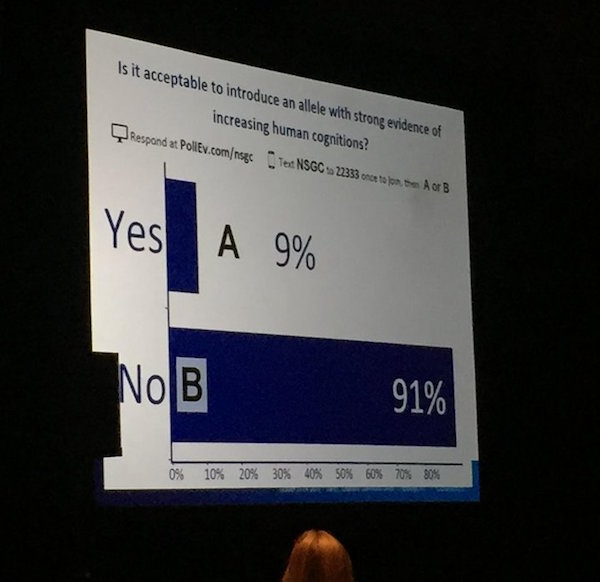
Greetings–
On Saturday, I gave a plenary talk at the annual meeting of the National Society of Genetic Counselors. I described the fast rise of CRISPR and encouraged the audience to consider the ethical questions that may arise if we gain the ability to fix diseases or even enhance traits in embryos. Laura Hercher, a genetic counselor at Sarah Lawrence College, also gave a talk in the session. She focused on mitochondrial replacement therapy, which is sometimes wrongly described as producing “three-parent babies.”
During our talks, Laura and I would stop from time to time to poll the audience about a series of ethical questions about gene editing. The picture above, taken by Carrie Blout, shows one result based on a scenario in which scientists identify a gene variant that improves cognition.
It’s not often a reporter gathers this sort of data, so I thought I’d share the results. I’ve uploaded the full results here. It’s interesting that genetic counselors were pretty comfortable with germline engineering to fix serious diseases, but not to protect people from diseases or enhance their traits.
A Flood of Ancient DNA
–There was a time when new reports on ancient DNA arrived at a manageable pace–once every couple months or so. Now the science is moving so fast that I sometimes end up writing about ancient DNA week after week.
This week is a case in point–just after writing about 5,000-year-old plague in European and Asian skeletons, I wrote about another study for the New York Times this past Monday. For the new story I move over to the New World. DNA from a pair of 11,500-year-old skeletons from Alaska offer some tantalizing clues about humans traveled from one hemisphere to the other. (See my earlier story on Kennewick Man for more on what ancient DNA can tell us about the peopling of the Americas.)
A Planet of Microbiomes
–In addition to my weekly “Matter” column, I also filed a story for the Thursday Times about the microbiome–or, to be more accurate, the world’s many microbiomes. We have communities of microbes inside our bodies, as do trees and oceans and tundras and undersea volcanoes. Each microbiome contains a different combination of species, most of which we don’t understand at all. The leading experts on microbiomes have come forward with a call for a national–perhaps even international–initiative to find the rules that bind all microbiomes together.
The Science Writing Resurgence
–Next spring, a new science magazine called Undark will be launching (I’m on the board of advisors.) Here’s an article in Columbia Journalism Review about what’s in store, and how Undark fits into the pleasing bloom of new science publications.
Speaking of new science publications, the folks at Stat have been working hard for months now getting ready to launch. They’ll be rolling Stat out very soon, so stay tuned. (As a national correspondent for Stat, I’ve been working on stuff you’ll be seeing soon, too.) In the meantime, you can check out their web site, where you can sign up for their richly informative daily newsletter.
The Talks
November 13, Providence, RI, at the National Association of Biology Teachers: I’ll be giving a talk in conjunction with receiving their Distinguished Service Award.
November 19, the New York City Genome Center: A panel discussion on “Jewish genomics” Details here.
January 28, the New Jersey Institute of Technology in Newark, NJ: Details to come.
New: June 23-25 International Society for Evolution, Medicine, and Public Health, Plenary Lecture. Durham North Carolina. Here’s the meeting site.
The End
–As always, if you have friends whom would you think would enjoy getting this newsletter, please let them know they can sign up at http://tinyletter.com/carlzimmer.
You can also follow me on Twitter, Facebook , LinkedIn, and Google+. And there’s always carlzimmer.com.
Best wishes, Carl
Originally published October 30, 2015. Copyright 2015 Carl Zimmer.